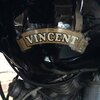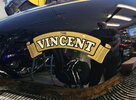Yes, that's correct. Sorry, I thought it was common usage but I suppose it is a strange use of the word which isn't very useful if you don't know the meaning the context I use it in.
'Flatting' or 'Flatting down' is generally used to refer to the process of using abrasive paper between coats of paint or primer during the finishing process to flatten the surface before applying subsequent coats.
It is pretty much impossible to get a mirror finish straight out of the gun (or it is for me anyway) so you usually 'flat' the surface with progressively smaller grade abrasives, starting with paper, then compounds, until a mirror finish is achieved.
However, when you have to apply a water slide transfer, the logical way would be to flatten down the final coat of colour until it is perfectly flat using a grade of abrasive paper, (usually wet or dry paper) of around 400-600 grade, apply the transfer then, once dry after a few days, apply a final few coats of clear lacquer which is then flatted down again as above but finishing off with fine compounds to achieve a mirror finish.
If you do this, however, the coat that you have flatted prior to applying the transfer becomes porous I am told, and so, after applying the transfer, followed by the lacquer, the lacquer can seep under the edges of the transfer and lift it which happened to me every time. Instead of the transfer looking like it is part of the paint, it looks like a transfer with clearly defined opaque edges at best or, at worst, it protrudes through the lacquer so it can't be flatted and polished without destroying it.,
There are three solutions. The first one is to not flat the paint at all. Just apply the transfer followed by the lacquer. I don't like this as I spray outdoors and inevitably get blemishes or dust in the paint. This isn't a problem as they disappear when flatted and polished but they don't dissapear if you just cover with lacquer. If you are a great painter with a dust-free environment then you can probably use this method.
The second solution is to apply the transfer on top of the paint and then flat the rest of the item you are painting around it, leaving a gap of 2-3mm then applying lacquer. This works fine but you may have some blemishes or maybe you put the last coat ion two thick and have a very orange peel surface.
The third solution, which I prefer, is to flat the whole surface as if you weren't applying any transfers. Once I'm happy with the surface, in the case of my Vincent tank, I mask off a rectangle maybe a centimetre larger than the transfer all around, then flat and polish to bring the surface back to a shine. Word of warning, DO NOT polish this with any silicon or wax based polish. Only use cutting compounds that are silicon & wax free or you lacquer will not stick. I then remove the masking tape, apply the transfer, wait a few days for it to dry and paint as previously advised.
Here's the tank I have just finished:
View attachment 36827
View attachment 36828
View attachment 36829
The gold leaf was interesting to do and took me several goes but, like most things, once you have figured it out it is quite easy. It just frustrating figuring it out!
You`ve done a fantastic job there Clay.


